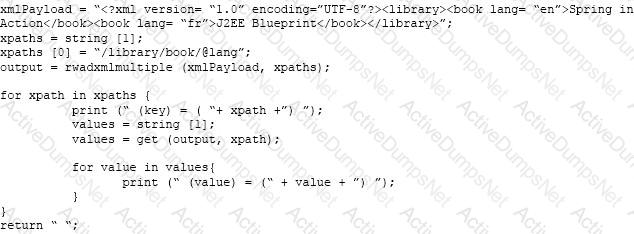Which two items are necessary to migrate between environments? (Choose two.)
When defining a new user, which Type value can grant a user account complete access to the CPQ Cloud site?
Identify two reasons why some or all transaction in a particular step are hidden for a user in Transaction Manager.
Which two are allowable methods of defining menu item choices for Single Select Menus attributes or Single Select Pick List attributes in the BOM Item Mapping table?
The following BML code in Config encountered an HTTP 404 error from someurl.com.

Which two statements are true? (Choose two.)
What is the order of execution when a new transaction is created?
In order to obtain additional sets of records when performing a REST call, which of the following sample URLs would a user use to obtain an additional 1000 records?
While designing the integration of a CPQ Cloud transaction with an external Order Management System, you must ensure that the transaction is submitted as an Order on a single-action-click from within CPQ Cloud.
Which two statements are true given this requirement?
How can action buttons be hidden in Commerce?
Your customer has sales organizations in two countries. The customer wants to make sure that users from one country have access only to quotes from that country.
How do you achieve this?
When doing a part search from home page, you have the Create Quote button to create a new Transaction.
How do you change the label of this button?
In Commerce, what is the order of operations for the standard Modify sequence?
What would you do if a partner organization is no longer needed and the access of all users needs to be removed?
Identify the three data types available for part custom fields. (Choose three.)
Given the following code:

What will be returned?
Which attribute type cannot be displayed on the line item grid?
Using standard functionality, how do you prevent a user from manually adding or removing rows in an array set?
In an existing implementation of CPQ, there is a system configuration with a system that has a root model and several child models that have a complex and hierarchical configuration.
As an administrator, which step should you choose to troubleshoot/debug the system in order to know which models and child items are configured in the entire system before adding the system to a transaction?
Your customer has a Configurator on a site with two Commerce processes. Which two options allow you to control in which Commerce process a new transaction will be created when starting from the Configurator?
How should an administrator set up a conditional restriction for access to a Product Family?
What is the limitation when searching entries in administration logs?
When using Web Services 1.0, consider the following sequence of a client system calling CPQ Cloud WebServices.
1. Call Security Login WebServices with User ID and Password.
2. Create a Commerce update Transaction WebServices call by using an existing transaction ID.
3. Make the following updates in the web service XML:
Set Session ID.
Set “_shipTo_first_name” to “myName”
4. Submit the WebService call.
5. Call Security Logout WebServices with the Session ID to close the session.
Based on the given sequence, which two statements are true? (Choose two.)
When creating a connection for a CPQ SOAP Endpoint in ICS, which format is expected?
Given the following function:

What does [n] specify?
Which statement is a proper definition of a Punch-In?
Which statement, when placed in the blank space in thecode snippetbelow, will set results = 25.0?
var = "25";
if (isnumber(var)){
______________________
}else{
results = 0.01;
}
return results;
Your customer wants to create a user that has complete access to the site and has the ability to add and edit new users.
Which procedure should you follow to accomplish this?
You are working with atransaction layoutin CPQ and need toadd a new panel with three columns.
Which is thecorrect approach?
Which are three testing strategies for Oracle CPQ Cloud? (Choose three.)
A use case requires displaying 250 rows of data to a user and allowing the user to interact with the data in a mobile interface.
What is the Oracle-recommended method for displaying an interactive 250-row data set in a Configurator?
Which two scenarios are valid for looping by using XSL Snippets? (Choose two.)
When Oracle CX Commerceself-service usersaccess an Oracle CPQ Configurator asguest users, how is the CPQ UI presented to the users?
Which two scenarios can be automated with File Transfer Protocol (FTP)? (Choose two.)
Identify three types of activities that are captured in Administration logs. (Choose three.)
Your users receive a notification for a transaction from CPQ when an approval has been retracted and is no longer needed. The notification contains a generic message about this action. However, users would like to get more details about the transaction.
What is the Oracle-recommended best practice to fulfill this requirement in CPQ?
Transaction revenue bycategory/typein Oracle CPQ refers to the total revenue generated by the sales of different types of products or services.
Transaction revenue by category can betracked and analyzedusing variousreporting and analytics tools.
If you want totrack transaction revenue by category/type, how would you implement that capability?
Along with Part Number, Quantity, and Price, you also want to send additional recommended item details from Configuration to Commerce by using a Recommended Item rule.
Which two options enable you to achieve this? (Choose two.)